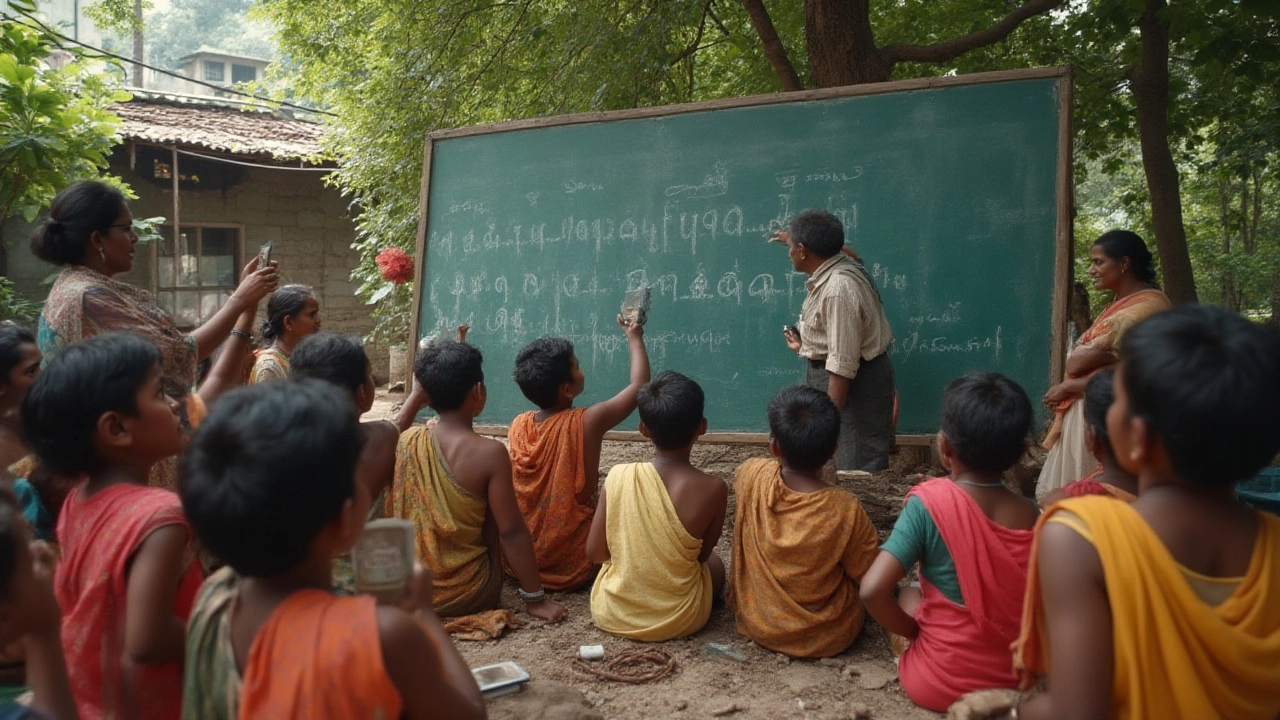Toughest Languages to Learn in India: Myths, Facts, and Real Challenges
 Jul, 18 2025
Jul, 18 2025
Try asking an Indian which language is the hardest to learn in the country. You’ll get a dozen different answers, each backed by a passionate defense. With more than 20 officially recognized languages (and hundreds if you count dialects), India is a jaw-droppingly diverse place for tongues. Some Indian languages feel friendly if you’re a beginner—while others look like they were designed to scare off outsiders. This isn’t just about tongue-twisters or weird scripts. It’s bone-deep grammar, a library of exceptions, pronunciation that threatens your jaw, and a culture loaded into every syllable.
The Real Contenders: Which Indian Languages Are the Toughest?
So, what are the “monsters” of the Indian language world? First, let’s ditch the old myth that Hindi must be the toughest just because it’s spoken widely. Actually, native Hindi speakers will tell you that Hindi grammar is more predictable than a Bollywood plot twist—tough, but get-through-able. Now, move your attention south or northeast, and you’ll see the real pain points. Here’s where things get fascinating.
Malayalam, mainly spoken in Kerala, is a monster to master if you don’t start young. Why? Let’s break it down. The Malayalam script has 52 letters. That’s more than the number of teeth in a shark’s mouth—try learning to read a newspaper with that! Its pronunciation uses sounds not found in English. For example, there are subtle differences in "l" sounds and "n" sounds that even most Indians who aren’t from Kerala just give up on.
If you think script is everything, try speaking Tamil. Tamil is one of the oldest living languages, with literature dating back over 2,000 years. But here’s the kick—it’s a diglossic language. Diglossia basically means that spoken Tamil and written Tamil are, for all practical purposes, two different languages. You could spend years learning to talk to a Tamil friend, then realize you can’t automatically read their literature or newspapers.
Check out this quick comparison table to see how some of the most notoriously tough Indian languages stack up:
| Language | Number of Letters | Script Difficulty | Phonetics Complexity | Main Spoken Where |
|---|---|---|---|---|
| Malayalam | 52 | Very High | High | Kerala |
| Tamil | 247 (with compounds!) | High | Very High | Tamil Nadu |
| Bengali | 50 | Medium | Medium | West Bengal |
| Kannada | 49 | High | Medium | Karnataka |
| Assamese | 41 | Medium | High | Assam |
| Hindi | 48 | Medium | Medium | North India |
Ever heard of Sanskrit? Some academics will claim it’s the hardest. It’s definitely the most precise—Sanskrit grammar has so many cases, forms, and poetic rules that monks and professors alike use cheat sheets. The catch is most people aren’t using it as their first language anymore. So sure, tough if you aim to get scholarly, but it doesn’t haunt day-to-day life.
Moving to the northeast, you hit languages like Manipuri (Meitei), which uses its own script (Meitei Mayek). That’s a whole new alphabet and entirely different sentence structure. Even native Hindi speakers often struggle with it.
The big pattern? Dravidian languages such as Malayalam, Tamil, Telugu, and Kannada show up whenever you ask which is the toughest. They all have lots of letters, maze-like scripts, and mind-bending sound differences. The Indo-Aryan lot (Hindi, Bengali, Marathi, Gujarati) tend to be friendlier—if you know one, the others come a little easier.

What Actually Makes a Language Tough?
You might wonder—is it just the script? Is it about memorizing the most words? Actually, it goes a lot deeper.
First up: script. Take Malayalam, for example. Its rounded letters look beautiful, but they’re merciless. For someone coming from the Latin alphabet (like English), getting the hang of even reading street signs can feel as slow as watching paint dry.
Then there’s pronunciation. Some languages—think Tamil and Telugu—ask your tongue to do things you didn’t know were possible (try pronouncing “zha” in Tamil without spraining something). These languages don’t just have new sounds; they split hairs between nearly identical ones, so a small slip changes the word totally.
Next is grammar. Dravidian languages often use an agglutinative structure, meaning they add lots of suffixes to words. Want to say “my younger brother”? In English, easy. In Malayalam, you combine family terms, gender, number, respect, and relation—all stacked up in a single word. Sentences stretch out with suffixes tacked onto verbs, subjects, objects. The details multiply like rabbits.
Vocabulary isn’t a walk in the park, either. If you know Hindi, other North Indian languages make sense faster. But jump down to Kannada or Malayalam, and suddenly hardly anything is familiar. Cognates—the lookalike words across languages—vanish. It’s like moving from Spanish to Russian instead of Spanish to Italian.
But here’s where it gets even trickier: spoken and written forms sometimes have an ocean between them. Take formal Tamil, used in textbooks or news: it looks ancient, the way Shakespeare sounds in English. Then go to a Chennai market, and you’ll hear the spoken version—whole grammar rules thrown out, pronunciation changed, words compacted. It’s like trying to master two versions at once.
Let’s not forget honorifics and social hierarchy. In some languages, you use certain verb forms or even completely different words to show respect, depending on who you talk to. Miss the right level of formality? Oops, you might offend someone or sound weirdly rude.
Learning resources matter big time. Compare Hindi or Bengali, where apps, classes, and online communities thrive, with Manipuri or Santali, which have almost nothing in the way of learning tools. No YouTube tutorials, no Duolingo course, sometimes not even a decent grammar book. That increases the difficulty tenfold. Motivation crashes fast when you’re learning solo.
Here’s a fact to chew on: according to the Language Difficulty rating from the Foreign Service Institute (FSI), South Indian languages are tagged as “exceptionally difficult” for English speakers. Not just for the script or grammar—but for the cultural context loaded into ordinary conversations. This isn’t just a handful of extra tenses; it’s rethinking how you see the world.
If you want to try for mastery, you have to live in the place, soak in the slang, eat the food, and maybe even pick up a few bad habits. Textbooks don’t really prepare you for a face-to-face chat in the local fish market—or poetry recited under the banyan tree.

Tips If You Want to Take on the Toughest Language in India
If you’ve read this far, you might be crazy or brave—or both! Picking up a tough Indian language isn’t for the faint of heart, but it’s hugely rewarding. Want some practical tips that’ll keep you sane on the journey? Here’s what people who’ve actually succeeded recommend:
- Start with the script: No shortcut here. Get down and dirty with writing. Make your own flashcards if needed, write out addresses, read children’s books—build muscle memory letter by letter.
- Find a local buddy: Nothing beats real talk with a native speaker. Don’t worry about mistakes. If you can, swap your English for their language in conversation exchanges. Join video calls, visit their town, or even game online if you need to.
- Immerse yourself: Watch movies, listen to music, sing along even if you sound off-key. Malayalam films are crazy popular for a reason—and you’ll pick up intonation, phrases, and cultural cues without even trying hard. Try mimicking dialogues for practice.
- Write diary entries: Even just a sentence per day. It boosts writing and thinking in that language. Over time, you’ll express more ideas and get creative.
- Pay attention to tone and formality: Ask your friends to break down how they’d say something to a child, versus how they’d speak to a boss.
- Learn proverbs and slang: Indian languages are stuffed with idioms that make locals laugh, cry, or just shake their heads when you use them right. Sprinkle in a proverb, and you’ll earn street cred instantly.
- Be patient with plateaus: Learning a language isn’t a steady climb. You’ll make leaps for weeks, then get stuck for months. That’s normal and happens to everyone.
- Think in the language: If you want to ask for water, practice forming the sentence in your head before reaching for the English.
Let’s be real, though. Most learners agree with this unspoken rule: if it scares you in the beginning, it’s probably the right one to pick. Life’s too short for easy wins. Malayalam, Tamil, Kannada—they’re hard because they keep the culture, the history, and the soul of their people tightly locked. The harder you try, the deeper you go, the more you realize it’s not about just learning words. It’s about cracking open an entirely new way to see and live.
Still itching to pick the toughest language in India? Go with Malayalam or Tamil if you want a real challenge—tough on your mouth, your mind, and your patience. But hey, on the flip side, you’ll never be short of conversation starters at parties.